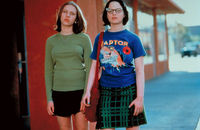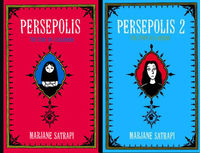Graphic Novel (On TV) Month: the Book vs. the Film, Part 1
By Carey Toane
Inspired by my conversation with Merril Collection librarian Lorna Toolis, I started thinking about how a shift from book into film can change the subtext of a graphic novel. I’m thinking generally here of how comics occupy a middle ground between books and film – more explicitly visual than a text-based book but less so than a movie. As such, a graphic novel as format exists in this liminal, outsider space that is often reiterated by the content: misfits, rebels, masked marauders, loners, and freaks.
Film, on the other hand, is most often produced in a rarified, exclusive world that few manage to enter. Taking a graphic novel from one to the other is bound to have some unintended effects, which are nonetheless noticeable to fans. The desire to see a beloved story translated out of our heads onto cellulose is matched only by the pleasure with which we critique the end result.
Because it's rare to find a graphic novel made into a television series (I couldn't find any!), I'm going to stretch the rules a bit and allow films to be included in this little sub-plot of this month’s Books and TV theme. Besides, as these recent survey responses have pointed out, we watch movies on our televisions and TV shows on our computers, so it's forgivable, right? Moving on.
My own bias expressed in reading interest means you’re not going to see any Marvel or DC adaptations treated here. A 90s alt-girl at heart, I've chosen two of my favourite graphic novels, Ghost World and Persepolis, as the first to feature in this series. The first is about two suburban girl friends in the still-awesome age of zines and plaid written by a man, and the other is a thematically similar coming of age story written by a woman on the other side of the world in Iran.
I have to call out some graphic novels and comics that I would pay to see on any size screen. Seriously, why isn't Alison Bechdel's Dykes to Watch Out For a hit series already? Who is optioning Mariko and Jillian Tamaki's Skim or That One Summer? Whither Maira Kalman's travel show or Chester Brown's CBC history specials or Kate Beaton's sketch comedy? You see what I did there?
Title: Ghost World
Actually a collection of comics by Daniel Clowes, Ghost World is a trip back in time to the early 90s world of alt-teen protagonists Enid Coleslaw and Rebecca Dopplemeyer, who read Sassy magazine, dye their hair green, and sneer at popular culture. Published in serial form in 1997, it was made into a movie starring Thora Birch and Scarlett Johansson in 2001.
There is all the suburban ennui and love triangles you'd expect of this era and genre, and it is beautifully drawn, but the real appeal of this graphic novel for me is the relationship between Enid and Rebecca. They strut and rant about music and men, they lie to save the other's feelings, they cry hard after they fight with each other. The intimacy and subtlety of women's friendships is hard to capture but I think Clowes does it with respect (he says that he identifies with both Enid and Rebecca), getting at the fragility and the strength of their dynamic. It passes the Bechdel test with flying colours.
Movie or book: Book. Somehow in the comics they still seem older than me, but in the movie they're reduced to a couple of sniggering little asses. I just can’t admire and relate to these girls as portrayed by these actresses the way I did in the comics. Maybe if it were animated it would be a different story, but much is lost with the aesthetic.
Title: Persepolis
Your CanLit News
Subscribe to Open Book’s newsletter to get local book events, literary content, writing tips, and more in your inbox
Conceived as a memoir in graphic novel form, Persepolis still preserves that epistolary rhythm that I like about comic strips. Author Marjane Satrapi draws her experiences growing up in Iran in the tumultuous 70s and 80s. The first book, published in 2000, ends when she leaves Iran for Europe, which leaves you with a false sense of hope. The animated film carries on through adolescence and high school to present day 2007, and was nominated for an Oscar that year.
Satrapi complicates and humanizes the history of her country through her own experience and is never sentimental or grandiose. If anything, the friendliness of her illustrative style – which reminds me of Charles M. Schulz – softens the blows while letting the comedy shine through.
Movie or book: Movie. Just barely, though. While the story is simplified in ways I don’t always like, the animation preserves Satrapi’s high-contrast style and just makes it live in all the ways I imagined it would when reading. Those who came to the novel from the film also won’t be disappointed. There should be a rule that graphic novel film adaptations have to be animated – if it meant they were all this great.
***
I'll have more on this next week, so stay tuned. In the meantime, feel free to email me with your thoughts at writer@openbooktoronto.com.
The views expressed in the Writer-in-Residence blogs are those held by the authors and do not necessarily reflect the views of Open Book: Toronto.
The views expressed in the Writer-in-Residence blogs are those held by the authors and do not necessarily reflect the views of Open Book.
Carey Toane is a librarian, journalist and poet. Her first collection of poems, The Crystal Palace, was published in 2011 by Mansfield Press. She lives in Toronto, where she is currently working on a collection of poems inspired by and dedicated to Twin Peaks. She is on Twitter at http://www.twitter.com/careygrrl
You can contact Carey throughout the month of May at writer@openbooktoronto.com




